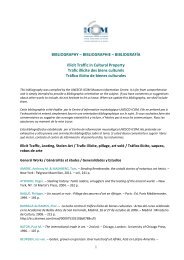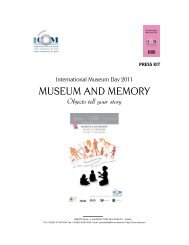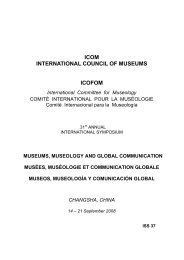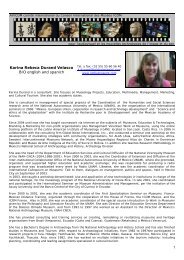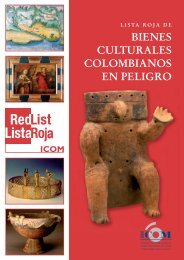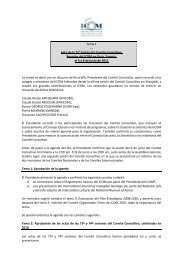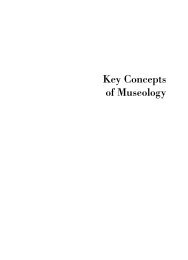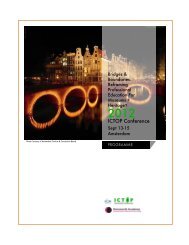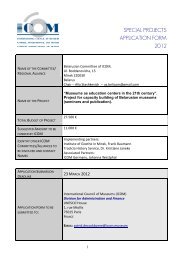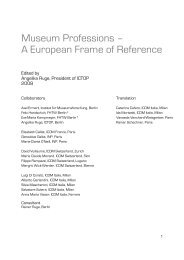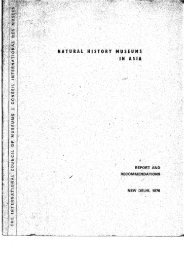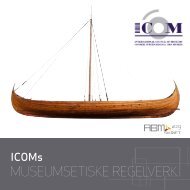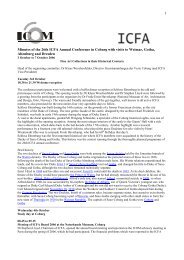ISS 25 (1995).pdf - The International Council of Museums
ISS 25 (1995).pdf - The International Council of Museums
ISS 25 (1995).pdf - The International Council of Museums
Create successful ePaper yourself
Turn your PDF publications into a flip-book with our unique Google optimized e-Paper software.
insitutional ideas <strong>of</strong> Pierre Bourdieu, George Dickie or Jurgen<br />
Habermas. <strong>The</strong> community can be understood as a brotherhood or<br />
sisterhood, as a group <strong>of</strong> specialists sharing the same belief . I<br />
have already mentioned the new museum generation tha t was<br />
created by the regional muse um system . <strong>The</strong> new pr<strong>of</strong>essionals<br />
were young, mostly scholars in art history and their only<br />
experience about museums was an occasionally obligatory two week<br />
museum course . This wasn't certainly an exception wi thin the<br />
history o f museum work. Rather, it is a tradition still very<br />
much alive. <strong>The</strong> belief or the pr<strong>of</strong>essional paradigm they had and<br />
their predecessors shared was tha t <strong>of</strong> a scholar , that <strong>of</strong> history<br />
<strong>of</strong> art.<br />
<strong>The</strong> concept paradigm has been introduced by philosopher Thoms S .<br />
Kuhn , who has studied history <strong>of</strong> science and scientific<br />
communities' . Any scientifique community is sharing the same<br />
pradigm to be able to continue its work. A shared paradigm is<br />
also a prerequisite for the development <strong>of</strong> science, still there<br />
cannot be any progress without animalias in the prevailing<br />
theories leading finally to revolutions creating new paradigms.<br />
<strong>Museums</strong> pr<strong>of</strong>ession has also got its own paradigms and the most<br />
influential part <strong>of</strong> the pr<strong>of</strong>essionals can be considered as a<br />
c ommunity <strong>of</strong> scholars. <strong>The</strong> scientifique world, scholars and<br />
researchers have experienced several revolutions and created or<br />
accepted new paradigms.<br />
But the paradigm we still implicitly hold, at least in art<br />
museums, is that <strong>of</strong> traditional museum described for example<br />
several times by Tomislav Sola as museum <strong>of</strong> the second wave<br />
being identified by collective pride, strive for eternity,<br />
idividualism or principle <strong>of</strong> science (being his tory <strong>of</strong> art in<br />
relation to art museums). This museum paradigm is crowned in the<br />
minds <strong>of</strong> art museum curators by another paradigm, that <strong>of</strong> the<br />
modernist idea <strong>of</strong> autonomous art. <strong>The</strong>se are the main elements in<br />
the community <strong>of</strong> art museum pr<strong>of</strong>essionals.<br />
<strong>The</strong>se quiding institutional paradigms <strong>of</strong> art museum and art<br />
prevented us, in spite <strong>of</strong> the good and idealistic aspirations we<br />
had from becoming an essential and active unit in the heritage<br />
action system and from aknowledging the true community and the<br />
diversity in it. When describing the Great European Museum'<br />
(Nordisk Museologi 2/ 1993), Kenneth Hudson says that it bears<br />
marks <strong>of</strong> community museum, but he excludes fine art museums and<br />
ethnological museums as candidates for the great museum, because<br />
they "overemphasize their value as institution and react very<br />
strongly against any suggestion that the concept <strong>of</strong> the Great<br />
Museum has anything to <strong>of</strong>fer them".<br />
Regional art museum and the feeling <strong>of</strong> community<br />
Referring to the concepts <strong>of</strong> the community museum and/ or the<br />
Great museum by Kenneth Hudson there is still one thing missing<br />
from our fine art museums as regional museums: the feeling <strong>of</strong><br />
community. This, in my opinion, is due to our pr<strong>of</strong>essional<br />
commitment. Our pr<strong>of</strong>essional paradigm is that <strong>of</strong> an art<br />
institution rather than the one <strong>of</strong> heritage action unit. We had<br />
a good start for the community orientated museum action brought<br />
up by the new cultural policies. Also art museums were supposed<br />
to create new policies for community and to focus on<br />
diversified, out-<strong>of</strong>-institution activities . <strong>Museums</strong> reached out<br />
91



